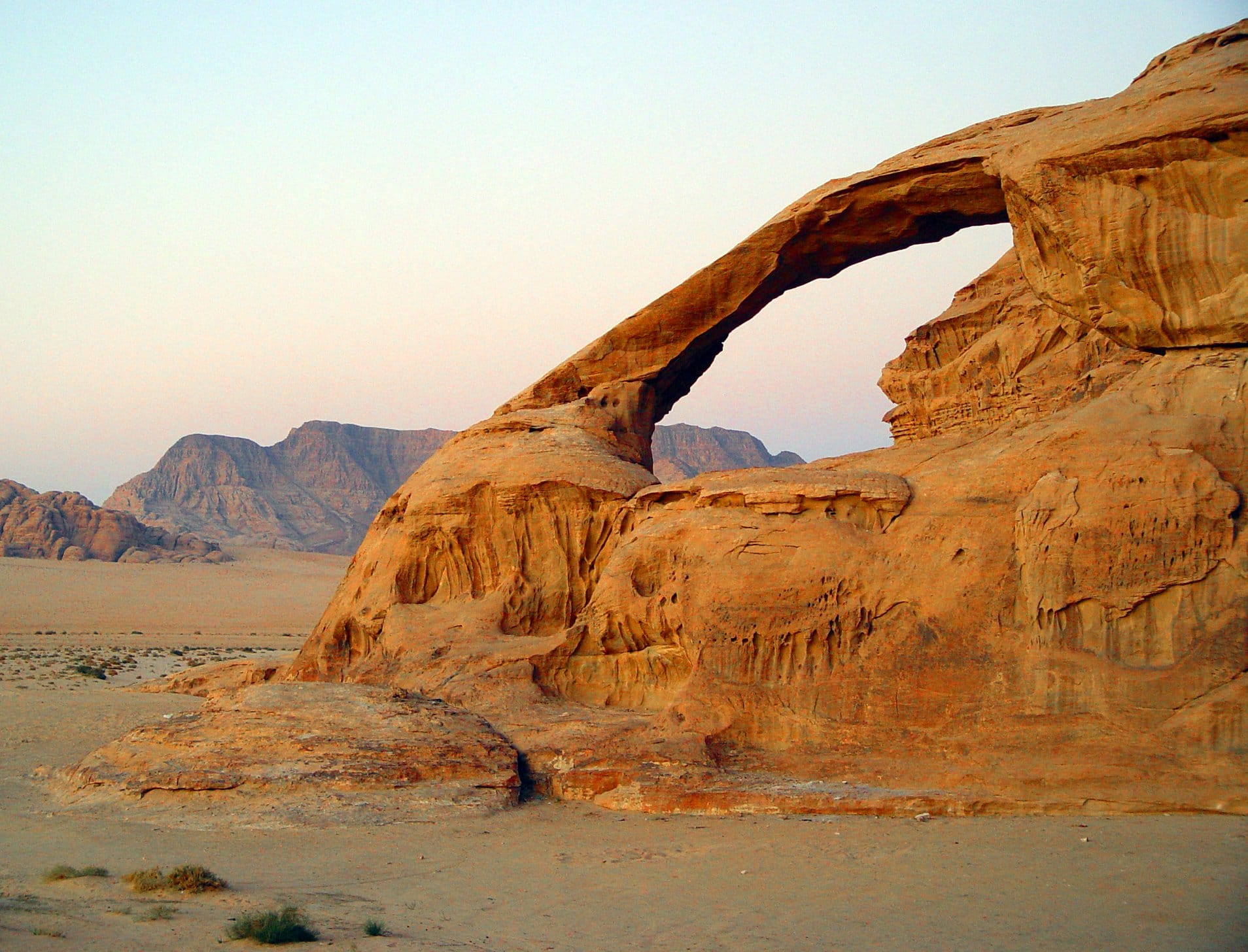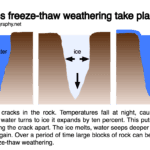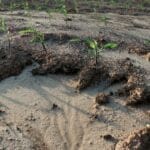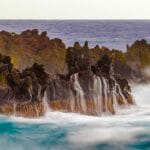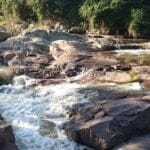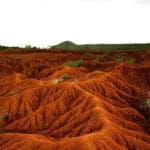Imagine the wind whispering secrets as it glides over rocks, gradually carving their edges. Imagine the rain, like a gentle sculptor, smoothing out the rugged surfaces. And finally, picture the mighty waves, relentlessly crashing against the coastline, shaping it with every surge. In this exploration, we’ll dive into the astonishing ways these natural forces transform our planet’s very skin, uncovering the fascinating secrets of weathering.
How do Wind, Rain, and Waves Cause Weathering?
Ever noticed how rocks in nature aren’t always sharp and jagged? That’s because they’re constantly being shaped and smoothed by the elements – a process called weathering. It’s like nature’s slow-motion sculptor, gradually wearing down even the toughest materials over time. Some of the most powerful tools in nature’s toolbox are wind, rain, and waves.
Let’s start with wind. Imagine a constant wind blowing across a desert, picking up tiny grains of sand. Now, those grains might seem harmless on their own, but when they’re blasted against a rock face day after day, year after year, they act like sandpaper, slowly grinding it down. This process, called abrasion, can carve out incredible formations like arches and hoodoos over thousands of years. Wind erosion, also known as aeolian erosion, is a key geological process that shapes the Earth’s surface, creating these distinct landforms.
Then there’s rain. You might think of rain as being soft and gentle, but it can be a powerful force of erosion, especially when you factor in temperature changes. Imagine water seeping into tiny cracks in a rock. When the temperature drops below freezing, that water turns to ice and expands, putting pressure on the surrounding rock. This freeze-thaw cycle, repeated over time, can eventually cause the rock to weaken and break apart.
And then we have waves, the relentless giants of the coast. Anyone who’s ever stood on a beach during a storm knows the sheer power of ocean waves crashing against the shore. Just like the windblown sand, the constant pounding of water and sediment can wear down even the toughest coastal rocks, shaping cliffs, carving out sea caves, and creating those beautiful, smooth pebbles you find on the beach. This process is further amplified by biogenic processes, like burrows and root systems, that can enhance wave erosion.
It’s important to remember that these weathering processes don’t happen in isolation. Temperature plays a big role, with warmer temperatures generally speeding up weathering reactions. The type of rock matters too, as some rocks are naturally more resistant to weathering than others. And then there’s chemical weathering, where water, acids in rainwater, and even gases in the air react with minerals in rocks, weakening them and changing their composition over time. This can lead to the formation of weathering deposits like caves and spires.
So, the next time you see a weathered rock formation, take a moment to appreciate the forces that shaped it. It’s a quiet but powerful reminder of the constant interplay between the Earth and its atmosphere, a slow dance of erosion and change that has been happening for millions of years.
How do Wind, Water, and Waves Cause Erosion?
We’ve been talking about how the Earth’s surface changes over time, but now, let’s delve deeper into the fascinating world of erosion. While weathering prepares materials for erosion, exposing fresh rock to further weathering, erosion itself is the process of transporting these materials away from their original location.
1. Wind Erosion: The Silent Sculptor
Ever felt a gust of wind so strong it almost knocked you off your feet? Well, imagine that force carrying tiny particles of sand and dust. Over time, this wind-driven sandblasting can have a dramatic effect on the environment. This process, known as wind erosion or aeolian erosion, is like nature’s sandblaster, gradually smoothing out rough surfaces and carving out intricate shapes in exposed rock. Think about the stunning sandstone arches in Arches National Park or the vast, rippling sand dunes of the Sahara Desert—those are prime examples of wind erosion at work, particularly in the Badain Jaran section of the Gobi Desert.
2. Water Erosion: A Force to be Reckoned With
We all know the feeling of a refreshing rainfall, but did you know those raindrops can pack a surprising punch? When raindrops hit bare soil, they dislodge tiny soil particles. As more raindrops fall, they create rivulets of running water that gather these loose particles and carry them away. This process, known as water erosion, can carve out gullies in the earth and, over time, even create vast canyons and valleys. Think of the awe-inspiring Grand Canyon—that’s millions of years of water erosion in action!
3. Wave Erosion: The Ocean’s Relentless Power
Picture the ocean’s waves crashing against a rocky coastline. Each wave that breaks releases a tremendous amount of energy, chipping away at the cliffs and rocks. This relentless pounding, combined with the abrasive action of sand and pebbles churned up by the waves, is what we call wave erosion. It’s a slow and steady process, but over time, it can carve out sea caves, arches, and stacks, sculpting dramatic coastal landscapes. Think of the iconic Twelve Apostles along Australia’s Great Ocean Road—a testament to the ocean’s erosive power. The impact of waves varies based on factors such as wave energy, shoreline morphology, and rock composition.
Erosion: A Balancing Act
While erosion is a natural process, human activities like deforestation and intensive agriculture can significantly accelerate it, leading to soil degradation and other environmental problems. Understanding the forces of erosion helps us appreciate the Earth’s dynamic nature and highlights the importance of protecting our planet’s delicate ecosystems. While scientists have made significant strides in understanding erosion, there’s still much we don’t know. For example, researchers are constantly studying how climate change might influence wind and water patterns, potentially impacting erosion rates in the future.
So, the next time you feel the wind on your face, observe a flowing river, or stand in awe of the ocean’s power, remember that you are witnessing the forces of erosion, constantly shaping and reshaping our planet.
How Does Wind Cause Weathering of Rocks?
We all know rocks are super tough, right? But even they can’t stand up to Mother Nature forever! Over time, wind, rain, and waves wear them down through the process of weathering. But how does wind, in particular, contribute to this process?
Wind Erosion – It’s Like Sandpaper on Steroids!
One of the main ways wind causes weathering is through erosion. Think of it like this: the wind picks up tiny particles of sand and dust. Then, it hurls them at rocks with crazy force. It’s like a constant sandblasting! Over time, this constant bombardment wears down the rock’s surface, smoothing it out and creating rounded shapes. This process of wind erosion is especially prevalent in deserts.
Abrasion – When Rocks Get a Serious Scrub-Down!
Remember those wind-blown sand particles? Well, they’re like tiny little sandpaper warriors! They scrape and grind against the rock, slowly wearing it down. This is called abrasion. It smooths out rough edges and creates those cool rock formations you see in places like deserts, like mesas and buttes.
Deflation – Wind Sweeping Rocks Off Their Feet!
Wind can also erode rocks in a sneaky way: by stealing! It carries away loose particles from the rock’s surface. This is called deflation. It can create depressions in the rock, which then get exposed to even more weathering.
Chemical Weathering – It’s Not Just About Force, It’s Also About Chemistry!
It’s not just about physical wear and tear, though! Wind also plays a role in chemical weathering. Think of it like this: wind carries moisture, salts, and other chemicals in the air. When these chemicals come into contact with the minerals in rocks, they can react. This can weaken the rock, making it more vulnerable to further weathering. It’s a bit like how metal rusts over time.
Want to Learn More?
We’re still learning a lot about weathering. It’s a complex process! Scientists are currently doing research to better understand how wind and other factors shape our planet. So, keep your eyes peeled for new discoveries!
Here are some things to think about:
- Different types of rocks erode at different rates. Some rocks are tougher than others.
- The climate plays a role in weathering. Dry climates tend to have more wind erosion.
- Weathering is a natural process that helps to shape our planet. It’s not all bad!
This is just a taste of how wind shapes our planet. There’s so much more to explore!
What are the Causes of Weathering?
We’ve been talking about weathering, the incredible process that shapes our planet’s surface. Weathering is the process of breaking down and altering the surface of the Earth by natural forces. It can be categorized into two types: physical weathering and chemical weathering. But what exactly drives this powerful force? Well, imagine weathering as a team of expert sculptors, each with their unique tools and techniques. We can categorize these artistic forces into three main types: physical, chemical, and biological weathering.
Let’s start with physical weathering, where rocks and minerals are broken down by, you guessed it, physical forces. This process takes place over long periods of time. If you are curious about how long does the weathering process take, click the link. Think of it like a constant push and pull that weakens the rock over time.
- Temperature swings: Ever noticed how things expand in the heat and contract in the cold? Rocks are no different! These constant temperature changes, especially in areas with extreme weather, can cause rocks to crack and break apart.
- Freeze-thaw cycles: Water is much sneakier! When it seeps into cracks in rocks and freezes, it expands like ice in a glass, putting pressure on the rock and widening the cracks. Over time, this repeated freezing and thawing can cause the rock to break apart.
- Abrasion: Imagine the slow, grinding power of glaciers or the constant buffeting of wind and waves carrying sand particles. This is abrasion in action, wearing down rocks like sandpaper on wood.
Next up, we have chemical weathering, where rocks and minerals undergo changes in their chemical composition. It’s like a microscopic makeover for these materials, changing their properties. Which of the following is an example of chemical weathering?
- Water: Don’t underestimate the power of water! It might seem harmless, but it’s a master at dissolving minerals in rocks, making them weaker and more susceptible to crumbling.
- Oxygen: Even the air we breathe plays a role! Oxygen reacts with certain minerals in rocks in a process called oxidation. Think of rust forming on metal – a similar process can occur with rocks, weakening them over time.
- Acids: We’re not just talking about strong laboratory acids here. Even slightly acidic rainwater, thanks to things like volcanic eruptions or pollution, can gradually dissolve rocks over long periods.
Finally, let’s meet the living sculptors: biological weathering, where living organisms contribute to the breakdown of rocks.
- Plants: As plants grow, their roots reach deep into the soil, seeking water and nutrients. These roots can wedge themselves into cracks in rocks, exerting pressure and eventually breaking them apart.
- Animals: From tiny insects to burrowing mammals, animals can also play a part. Their activities, like digging and burrowing, can contribute to the physical breakdown of rocks and expose fresh surfaces to other weathering agents.
- Microorganisms: Don’t forget about the little guys! Bacteria and fungi release chemicals that can break down rock minerals, contributing to weathering in a subtle but significant way.
It’s important to remember that weathering is a complex process often involving multiple forces working together. For example, a rock weakened by chemical weathering might be more susceptible to breaking apart due to physical weathering.
While we’ve made significant strides in understanding these processes, research is ongoing, and scientists are constantly making new discoveries about the intricate ways weathering shapes our world. So, the next time you see a weathered rock formation, take a moment to appreciate the incredible forces that have been at work for perhaps thousands or even millions of years!
How Can Waves Contribute to the Weathering of Rock?
We’ve already talked about how powerful waves can be, but have you ever thought about how they wear down rocks? Imagine it as a continuous cycle of disintegration and sediment formation. It’s like a constant push and pull that reshapes the coastline over time.
Think about a wave crashing against a cliff. It doesn’t just splash harmlessly; it slams into the rock with a surprising amount of force. This impact can cause tiny cracks or even break off larger chunks, especially if the rock is already weakened by things like pre-existing fractures.
But it’s not just the water itself doing the work. Waves often carry sand, pebbles, and even larger rocks that have been churned up from the seafloor. When these abrasive particles are hurled against the shore, they act like sandpaper, grinding away at the rock face. It’s a slow and steady process, but over time, it can dramatically smooth out rough edges and wear down even the toughest cliffs.
Now, not all rocks are created equal. Some, like granite, are incredibly hard and resistant to erosion. These tough customers can withstand wave action for centuries, even millennia. Others, like softer sandstones or clays, are much more vulnerable and might show significant wear and tear after just a few decades or even years.
The intensity of the waves also plays a major role. Big, powerful waves generated by storms can pack a much bigger punch than the gentle lapping of a calm sea. These powerful waves can cause much more erosion in a shorter period, dramatically altering the coastline.
And then there’s the shape of the coastline itself. Areas with steep cliffs exposed to the full force of the waves will erode much faster than sheltered bays or gently sloping beaches. It’s all about how much energy from the waves is focused on a particular spot.
There’s still a lot that scientists are trying to understand about how waves contribute to coastal erosion and shape our coastlines. For example, climate change is influencing wave patterns and sea levels, which could lead to even more dramatic changes in the future. Scientists are already investigating the potential for using wave energy as an alternative source of renewable energy while considering its potential impact on coastal erosion. So, the next time you’re at the beach, take a moment to appreciate the power of the waves and the slow, steady work they do in shaping our planet. It’s a fascinating process that reminds us of the incredible forces of nature at play all around us.
- China II Review: Delicious Food & Speedy Service - April 17, 2025
- Understand Virginia’s Flag: History & Debate - April 17, 2025
- Explore Long Island’s Map: Unique Regions & Insights - April 17, 2025
